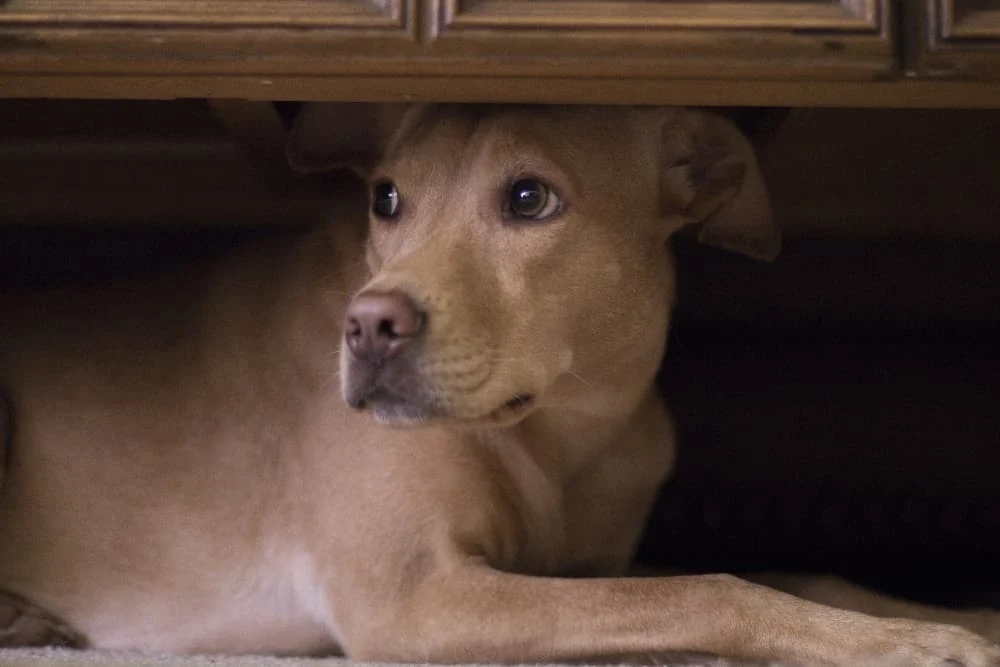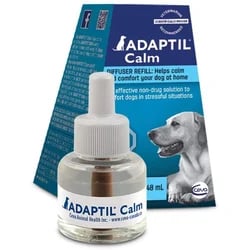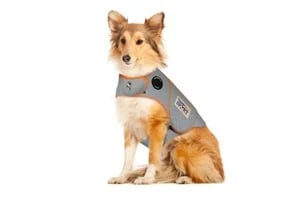
Is your dog scared of thunder? Does he pace, whine, and pant as those ominous, dark clouds start to roll in? What to do when a dog is scared of thunder?
Seeing your dog scared of thunder can be painful to watch. Like many dogs who shudder at the sound of rumbling thunder, your dog may seem unusually sensitive to any storm-related occurrence, such as the change in wind direction and sudden coldness, to name a few.
And once the rumbling starts, your dog suddenly whimpers, runs all over the place, hides in the closet, clings to you, or even starts to obsessively groom due to overwhelming terror.
This extreme reaction is known as thunderstorm phobia and is relatively common among dogs. Also known as astraphobia, it can affect both dogs and humans. And just like other phobias, you shouldn't ignore your dog’s fear of thunder.
Matt Peuser, DVM, who is a resident veterinarian at Olathe Animal Hospital, says through Fetch,
“Most of the time they don’t grow out of it on their own, and many will get worse with time if nothing is done.”
If your dog is panting during a storm and cowering in fear after a booming thunder, then there’s no need to panic. In this article, we will delve into the root cause of this fear, its symptoms, and how you can help your dog manage it effectively.
Why Are Dogs Scared of Thunder?
For most dogs, the sound of thunder, just like construction noise, fireworks, and gunshots, is what upsets them. For other dogs, it’s all the things that come with the storm: thunder, lightning, changes in barometric pressure, the scent of rain, static electricity, and other pre-storm occurrences that humans can’t perceive.
Dr. Ragen T.S. McGowan, a behaviour research scientist at Purina:
“Depending on a dog’s personality and past experiences, different parts of a thunderstorm can cause fear or anxiety. There’s usually more buildup before a thunderstorm than with fireworks (e.g., changes in the barometric pressure, high winds, rain, hail and/or lightning), thus dogs might learn to expect thunder.”
According to Nicholas Dodman, a veterinary behaviourist at Tufts University, as featured in National Geographic, static buildup in their fur may be another cause of anxiety. Larger dogs usually have a higher risk for static energy buildup. In humans, this happens when we wear a sweater and get a sudden shock from the car door if we’re not wearing rubber-soled shoes.
Dog Storm Anxiety Symptoms

Because storm changes are indiscernible to us, it may seem that they’re misbehaving or acting strangely. But the truth is, since dogs cannot express their anxieties in words, they have to communicate through body language.
Dogs display a variety of behaviours or responses during a thunderstorm, but here are some common canine storm anxiety symptoms you should watch out for:
-
- Lowered tail and ears
- Widened eyes
- Drooling
- Panting
- Howling or Whining
- Clinging to humans
- Shivering or shaking
- Hiding
- Involuntary urination
- Destructive behaviour (running away, bumping into furniture, clawing in, etc.)
Subtle signs of anxiety that can be challenging to spot include the following:
-
- Showing the white parts of their eyes
- Lip licking
- Looking away from the owner
- Lifting a paw
- Rapid heartbeat
How to Calm Dogs in a Thunderstorm

While there is no cure for thunderstorm anxiety, there are several ways to help your dog cope with fear. You can do any of the following tips:
Provide a safe space
Before a storm, prepare a safe indoor space for your furry companions, like a kennel or crate. Leave the door open so your dog won’t feel trapped inside. If your dog isn’t used to being inside a crate, you can repurpose a small bathroom or a corner. Make sure to help your dog become familiar with the area weeks before the rainy season hits. Why is my dog scared of thunder?
Fill the space with your dog’s favourite toys, a soft and comfortable bed, and a water bowl to prevent dehydration. If the room has windows, make sure to close the blinds and curtains so your dog bed won’t be able to see the flash of lightning outside.
Find out more about the benefits of crate training in our Foolproof Guide to Crate Training.
Distract Your Dog
If frequent booming thunder is unsettling for your dog, consider playing calming music or using a white noise machine to drown out the sound of the storm.
If your dog wants to play with you, then give them your undivided attention. You can also distract them with long-lasting chews and toys. The more occupied they are, the less they will worry about the booming storm outside.
Accompany Your Pooch
Don’t leave your dog outside in the pouring rain alone. Keep your dog inside with you except for potty breaks, and avoid leaving them home alone if possible.
This might be a good time to look into doggy daycare or ask a friend or family member to hang out with your pooch during the storm.
What Can I Give My Dog for Storm Anxiety?
It’s not easy to watch your pet suffer, especially when you can’t do anything to remove the triggers.
A consistent routine for dealing with dogs who are scared of thunder will help, but if any of the mentioned tips weren’t effective, consider trying one of these natural remedies for a dog who is afraid of thunder:
Give a Calming Massage
Help your dog get through the stress by stroking the back, rubbing the forehead, massaging the thighs and glutes, and probably their favourite - rubbing the ears and neck. Make sure to use gentle pressure on these points.
Use a Diffuser

Use the calming powers of an essential oil diffuser, like lavender oil, chamomile, rose, or lemon. Not all essential oils are dog-safe, so make sure you know how to use them safely.
Dog pheromones also help reduce anxieties, like those in Adaptil Calming Diffusers.
This diffuser releases a pheromone that mimics the same pheromone given off by mother dogs to their anxious puppies. It’s also available in sprays so you can treat specific areas, like crates or small rooms.
ThunderShirts

A snug, comfortable garment can give a “swaddling” effect to anxious dogs. This may seem too easy to be true, but they are typically very effective for anxious dogs.
The comforting wraps can reduce anxiety by calming both the psychological and physical anxiety reactions, like shaking and cowering. One of the most well-known products is the Thundershirt.
This tight vest embodies a warm hug to soothe your anxious dog. Just like parents swaddle their babies to calm them down, a Thundershirt applies constant, gentle pressure to your furry companion’s body. How to help a dog scared of thunder?
It is scientifically proven that gentle pressure from this comfortable wrap releases endorphins, chemicals released by the body to relieve pain and stress. This technology is not new for people, but has been adapted to dogs and cats who suffer from anxiety.
Sometimes called a thunder vest or thunder jacket, this breathable polyester wrap is up to 80% effective for dogs and cats and comes with a 100% money-back guarantee!
Calming Dog Treats
To help your dog chill out, calming dog treats can be helpful. Many natural ingredients have calming properties that can help your dog stay relaxed in stressful situations.
Unlike the external options above, calming treats work from the inside out, so they don't work quite as quickly. They are best used when planning ahead of a storm. Try feeding a calming treat 30 minutes to an hour before the storm sets in.
Here are a few of our favourite calming treats:
What to Do Before a Thunderstorm
One way of mitigating some of your pup's anxious behaviours is to plan ahead of the storm. You can't control the weather, but you can take a few steps to get your dog in the right state of mind to be able to handle the storm better.
Here are a few habits to get yourself and your dog into before the next storm hits:
1. Exercise
Just before a stormy day, go out with your four-legged best friend for an outdoor activity. Exercise will help prepare your dog’s physical and mental states. In addition, many veterinarians claim that physical activities can help boost natural serotonin levels, which help stabilize an anxious dog’s mood. How to calm a dog down during a storm?
Exercise for dogs, such as a 30-minute walk outside, hiking, jogging, swimming, and frisbee, can help burn off steam and condition them for an upcoming stressful event.
2. The More the Merrier
More often than not, bringing home a new dog will enrich your anxious dog’s quality of life. Since dogs are highly social creatures, your current dog might appreciate it if they have someone to play with in times of stressful moments.
Also, make sure to pair dogs with lifestyle, behaviour, and activity similarities. For instance, a dog who loves snuggling indoors may encounter challenges with a dog that loves outdoor activities.
Only consider this option when you are physically, financially, and mentally ready to accommodate a new family member. Be really sure you are Ready for a New Dog.
As a test, or for short-term fixes, a doggy playdate might be a better option, especially if your dog has a bestie that will help safely keep him distracted.
3. Try Desensitizing Them
You can help desensitize your pooch to rumbling storm sounds by playing a recording of thunder at a low volume on days without storms. If your dog didn’t show symptoms of anxiety, offer a treat or a stuffed toy for counterconditioning so that your furry friend can associate a negative occurrence (storm) with something positive (treats or toys).
Play storm sounds from your mobile phone or laptop at a soft level. If your dog remains calm at this level, utter a command like “calm” and give a treat every 15-30 seconds. Afterward, slowly extend the time your dog needs to stay relaxed before rewarding with a treat.
If your pup remains calm after several commands, increase the volume and then repeat the process. Should your pet exhibit pronounced anxiety, fear, or panic, decrease the volume, say the command, and then give a reward. This process will help condition your pooch during an actual storm.
What Happens When Storm Anxiety Goes Untreated?

Just like any other problem, storm anxiety may be exacerbated when left untreated. For example, a dog that started with mild issues, when left untreated, can exhibit destructive reactions such as destroying furniture and running away.
What could start as some whining or hiding could lead to your dog seriously injuring themselves, especially if they are left alone or locked up.
Ignoring the behaviour will not help. Though your dog may be a tough guy most of the time, he will always look to you for protection when he’s scared. Take note of odd behaviours before and during a storm, and take appropriate action to calm your pooch.
When to Call Your Vet
However, if you notice that your dog's anxiety symptoms have worsened over time, consult your veterinarian to find out whether your dog is suffering from storm anxiety, separation anxiety, noise anxiety, or a combination of all these fears.
Usually, veterinarians recommend a course of desensitization and behaviour modification to help manage your dog's anxiety levels during a thunderstorm.
As such, your veterinarian can also recognize the need for anti-anxiety medications or sedatives to be used in the event of a raging thunderstorm.
Whether your dog has been struggling from fear of booming thunderclaps and flashes of lightning for years or you're simply looking for tips to prevent your pup from developing such anxiety, dealing with thunderstorm anxiety requires perseverance, patience, and preparation.
Once you know how to recognize the symptoms, you can help your dog weather the storm by providing support and a safe and comfortable place to hunker down.
Frequently Asked Questions About Dogs and Thunderstorms
Why are some dogs scared of thunderstorms?
Many dogs are sensitive to loud noises, bright flashes of lightning, and changes in barometric pressure associated with thunderstorms, which can trigger fear and anxiety.
What are the common signs that a dog is scared of thunder?
Signs of thunderstorm anxiety in dogs may include panting, trembling, pacing, hiding, excessive drooling, whining, or seeking comfort.
Should I cuddle my dog during thunderstorms?
This depends on your dog's comfort level, but sitting with them, petting them, and verbally reassuring them can help to reduce their anxiety during the storm. If your dog is a cuddle bug, then cuddle away; if your dog is more comfortable sitting at your feet, then just aim to be present.
Are there medications or supplements that can help calm a fearful dog during thunderstorms?
Yes, your veterinarian can prescribe medications or recommend supplements like melatonin or CBD to help reduce anxiety in dogs during thunderstorms.
Can behaviour training help dogs overcome their fear of thunder?
Behaviour modification techniques, such as desensitization, can help dogs become less fearful of thunderstorms over time.
Should I consult a professional if my dog's thunderstorm anxiety is severe?
If your dog's fear of thunderstorms is severe and interfering with their well-being, consulting a professional dog trainer or a veterinary behaviourist may help.
.png?width=200&height=66&name=logo%20(1).png)





